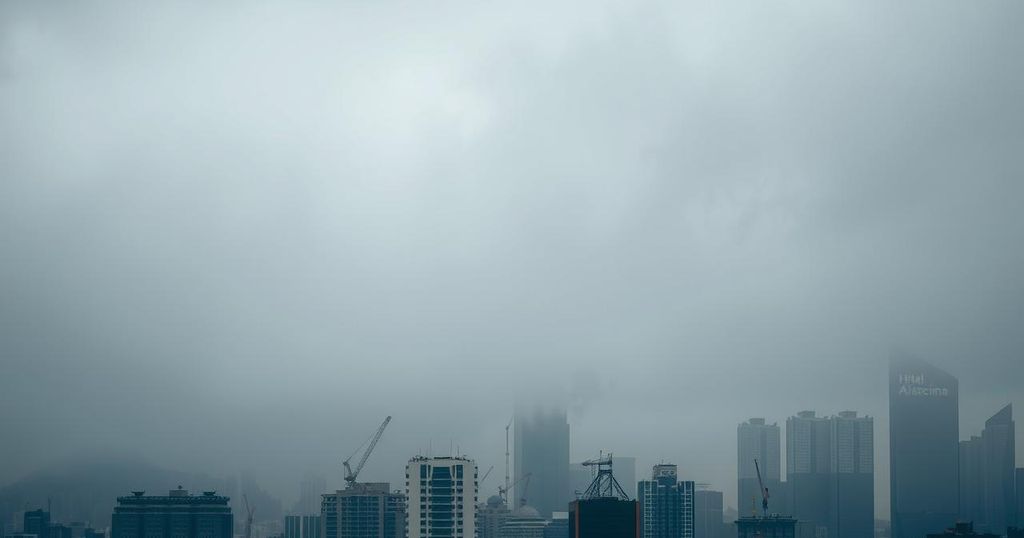Bangladesh’s Alarming Air Quality: A Global Health Concern

In 2024, Bangladesh was the second most polluted country with PM2.5 levels of 78 µg/m³, behind Chad. Dhaka ranked as the third most polluted capital. Only seven countries met WHO air quality standards. The discontinuation of U.S. global air quality monitoring complicates efforts to address pollution. Air pollution poses severe health risks, contributing to millions of deaths globally.
Bangladesh ranked as the world’s second most polluted country in 2024, with smog levels exceeding World Health Organization (WHO) guidelines by more than 15 times, according to the Swiss air quality monitoring firm IQAir. The average PM2.5 level in Bangladesh was recorded at 78 micrograms per cubic meter (µg/m³), making it second only to Chad, which had an alarming level of 128 µg/m³. Following Bangladesh, Pakistan, the Democratic Republic of the Congo, and India ranked third, fourth, and fifth respectively, with PM2.5 levels of 73.7 µg/m³, 58.2 µg/m³, and 50.6 µg/m³.
In terms of specific locations, Dhaka emerged as the world’s third most polluted capital in 2024, matching Bangladesh’s average PM2.5 level of 78 µg/m³. The most polluted capital was New Delhi at 91.6 µg/m³, followed closely by N’Djamena, Chad’s capital, at 91.8 µg/m³. Other capitals included Kinshasa, the capital of the Democratic Republic of the Congo at 58.2 µg/m³, and Islamabad, Pakistan’s capital at 52.4 µg/m³.
The data, released by IQAir, indicated that only seven countries—Australia, New Zealand, the Bahamas, Barbados, Grenada, Estonia, and Iceland—achieved WHO air quality standards in 2024. Researchers highlighted that combating smog is expected to become increasingly difficult following the U.S.’s decision to discontinue its global air quality monitoring efforts. India reported a 7% decline in its PM2.5 levels to 50.6 µg/m³ but still had twelve of the world’s twenty most polluted cities.
This comprehensive study encompassed over 40,000 air quality monitoring stations across 138 countries, revealing that only 17% of global cities met the WHO’s recommended PM2.5 levels of no more than 5 µg/m³ in 2024. Significant data gaps exist, particularly in Asia and Africa, as many developing nations have relied on U.S. embassy-installed air quality sensors for monitoring pollution. This reliance is now threatened due to budget constraints leading to the cessation of the program by the U.S. State Department.
Frank Hammes, Global CEO of IQAir, remarked, “Air pollution remains a critical threat to both human health and environmental stability, yet vast populations remain unaware of their exposure levels.” He underscored the acknowledgment by the U.S. of access to clean air as a universal human right. As per WHO statistics, an astonishing 99% of the global population resides in areas failing to meet recommended air quality levels, positioning air pollution as a significant global health risk.
Air pollution is notably recognized as the second leading risk factor for global mortality, with 8.1 million deaths attributed to poor air quality in 2021 alone. Moreover, high levels of PM2.5 exposure correlate with various adverse health conditions, including asthma, cancer, and respiratory diseases. Additionally, such exposure during pregnancy and early childhood can lead to critical health issues, such as heart defects and cognitive impairments.
In conclusion, the findings by IQAir reveal a concerning state of air pollution in Bangladesh, as the nation ranks second globally in terms of poor air quality. The data emphasizes the urgent need for improved monitoring and pollution control measures, particularly in developing countries. With the U.S. discontinuing its monitoring support, it becomes crucial for nations to address air quality challenges to protect public health and ensure environmental stability.
Original Source: asianews.network






